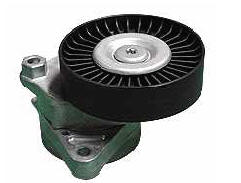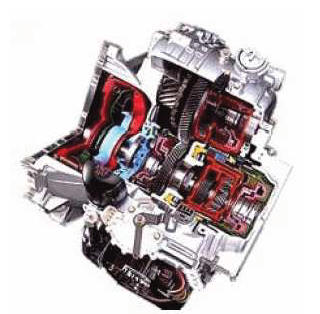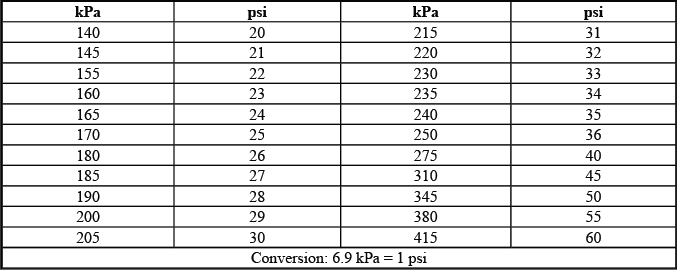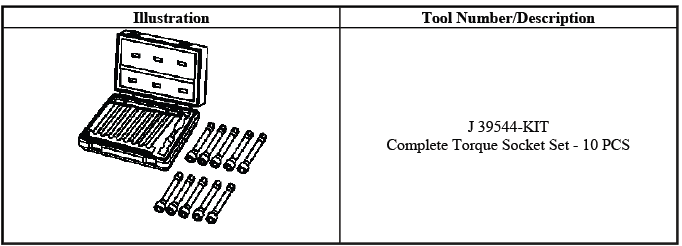Buick Enclave: Description and Operation
ALL SEASONS TIRES DESCRIPTION

Fig. 22: Identifying All Seasons Tire Marking
Most GM vehicles are equipped with steel belted all-season radial tires as standard equipment. These tires qualify as snow tires, with a higher than average rating for snow traction than the non-all season radial tires previously used. Other performance areas, such as wet traction, rolling resistance, tread life and air retention, are also improved. This is done by improvements in both tread design and tread compounds. These tires are identified by an M + S molded in the tire side wall after the tire size. The suffix MS is also molded in the tire side wall after the TPC specification number.
The optional handling tires used on some vehicles now also have the MS marking after the tire size and the TPC specification number.
GENERAL DESCRIPTION
The factory installed tires are designed to operate satisfactorily with loads up to and including the full rated load capacity when these tires are inflated to the recommended pressures.
The following factors have an important influence on tire life:
- Correct tire pressures
- Correct wheel alignment
- Proper driving techniques
- Tire rotation
The following factors increase tire wear:
- Heavy cornering
- Excessively rapid acceleration
- Heavy braking
METRIC WHEEL NUTS AND BOLTS DESCRIPTION
Metric wheel/nuts and bolts are identified in the following way:
- The wheel/nut has the word Metric stamped on the face.
- The letter M is stamped on the end of the wheel bolt.
The thread sizes of metric wheel/nuts and the bolts are indicated by the following example: M12 x 1.5.
- M = Metric
- 12 = Diameter in millimeters
- 1.5 = Millimeters gap per thread
P-METRIC SIZED TIRES DESCRIPTION

Fig. 23: Identifying P-Metric Sized Tire Marking
Replacement tires should be of the same tire performance criteria (TPC) specification number. This will ensure the same size, the same load range and the same construction as those originally installed on the vehicle.
REPLACEMENT WHEELS DESCRIPTION
Replace the wheel if any of the following conditions exist:
- The wheel exhibits excessive runout.
- The wheel is bent.
- The wheel is cracked.
- The wheel is severely rusted.
- The wheel is severely corroded.
- The wheel leaks air.
NOTE: Air leaks caused by porosity on aluminum wheels are repairable.
WARNING: If you are replacing the wheel(s), the wheel stud(s), the wheel nut(s) or the wheel bolt(s), install only new GM original equipment parts.
Installation of used parts or non-GM original equipment parts may cause the wheel to loosen, loss of tire air pressure, poor vehicle handling and loss of vehicle control resulting in personal injury.
CAUTION: The use of non-GM original equipment wheels may cause:
- Damage to the wheel bearing, the wheel fasteners and the wheel
- Tire damage caused by the modified clearance to the adjacent vehicle components
- Adverse vehicle steering stability caused by the modified scrub radius
- Damage to the vehicle caused by the modified ground clearance
- Speedometer and odometer inaccuracy
Replace the wheel, the wheel studs and the wheel/nuts or the wheel bolts if applicable, if any of the following conditions exist:
- The wheel has elongated bolt holes.
- The wheel/nuts or bolts if applicable, loosen repeatedly.
Steel wheel identification is stamped into the wheel near the valve stem.
Aluminum wheel identification is cast into the inboard side of the wheel.
STEEL WHEEL REPAIR DESCRIPTION
CAUTION: Do not heat wheels in an attempt to soften them for straightening or repair damage from striking curbs, etc. Do not weld wheels. The alloy used in these wheels is heat-treated and uncontrolled heating from welding affects the properties of the material.
CAUTION: The use of tubes in tubeless tires is not a recommended repair due to the fact that speed ratings are greatly reduced.
You can repair porosity in aluminum wheels. If leaks are found in a steel wheel, replace the wheel with a wheel of original equipment quality.
TIRE INFLATION DESCRIPTION
When you inflate the tires to the recommended inflation pressures, the factory-installed wheels and tires are designed in order to handle loads to the tire's rated load capacity. Incorrect tire pressures or under-inflated tires, can cause the following conditions:
- Vehicle handling concerns
- Poor fuel economy
- Shortened tire life
- Tire overloading
Inspect the tire pressure when the following conditions apply:
- The vehicle has been sitting at least 3 hours.
- The vehicle has not been driven for more than 1.6 km (1 mi).
- The tires are cool.
Inspect the tires monthly or before any extended trip. Adjust the tire pressure to the specifications on the tire label. Install the valve caps or the extensions on the valves. The caps or the extensions keep out dust and water.
The kilopascal (kPa) is the metric term for pressure. The tire pressure may be printed in both kilopascal (kPa) and psi. One psi equals 6.9 kPa.
Inflation Pressure Conversion (Kilopascals to PSI)

Tires with a higher than recommended pressure can cause the following conditions:
- A hard ride
- Tire bruising
- Rapid tread wear at the center of the tire
Tires with a lower than recommended pressure can cause the following conditions:
- A tire squeal on turns
- Hard steering
- Rapid wear and uneven wear on the edge of the tread
- Tire rim bruises and tire rim rupture
- Tire cord breakage
- High tire temperatures
- Reduced vehicle handling
- High fuel consumption
- Soft riding
Unequal pressure on the same axle can cause the following conditions:
- Uneven braking
- Steering lead
- Reduced vehicle handling
Refer to the Tire Placard for specific tire and wheel applications and tire pressures.
TREAD WEAR INDICATORS DESCRIPTION

Fig. 24: View Of Tread Wear Indicators
The original equipment tires have tread wear indicators that show when you should replace the tires.
The location of these indicators are at 60º intervals around the outer diameter of the tire. The indicators appear as a 6 mm (0.25 in) wide band when the tire tread depth becomes 1.6 mm (2/32 in).
SPECIAL TOOLS AND EQUIPMENT
SPECIAL TOOLS


